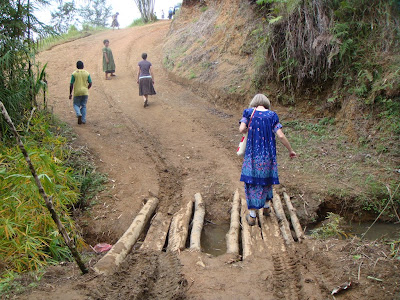
Today, we went to the mountaintop village of Konduk (/KOHN dook/) for a baptism there. We were told it'd be about an hour's walk up the mountain, but we had enough people going that we took one of the Landrovers instead. I'm glad we did, as the road started as a
very uneven stone road and then we turned off it onto a dirt road. You can see one of the wooden bridges to the right. Some of the group decided to walk over the bridges rather than ride. I'm not entirely sure I blame them for that, as it was an interesting ride.
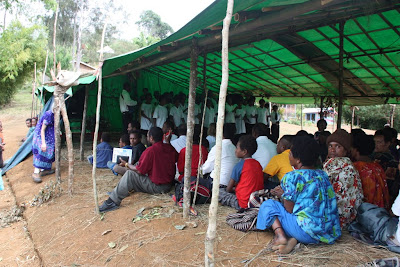
When we got there, they were doing a worship service before the actual baptisms. They had several people being baptized today, I believe I heard the number 16, but I'll admit I didn't get a full count. (And some were rededications, and just gave testimony, but more on that later.) It seems one of the elders in the church had recently died of leukemia and that death moved a number of his family to come to the church. The service was in the middle, though its order seemed similar to the Sunday services I've been to here (and elsewhere, to some extent, though I found similarities in worship services in Shinto shrines). They were singing English worship songs, some of which I knew or were similar enough to ones I knew. The spoken parts were a mixture of Tok Pisin and
tok ples, that is one of the local languages. In the image, those in white tops and black pants or skirts were the baptisees. The congregation sat in two sides, the left side had most (all but one or two) of the men and a few women, the right was nearly all female. I'm not sure if it's a conscious decision to sit as such, the missionaries do not follow this tradition if it is one.
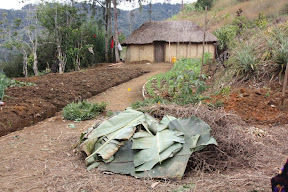
There was a sermon that I could almost follow in Tok Pisin in places, and then it would switch, I assume to the
tok ples and I would be lost for a moment. It was on Matthew 4 and fighting agianst the temptations of Satan, even after baptism. When the sermon finished, we walked further up the hill, past where they were preparing the traditional Papuan feast in a
mumu, an oven dug into the dirt, filled with hot rocks and then the food (pork) being cooked and covered with earth, straw and leaves. (See right.)
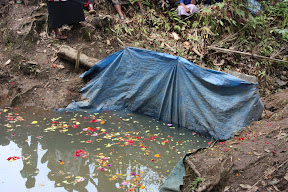
Up the hill, and past some of the town gardens was where they had dammed up a part of a stream (or it might have been a drainage ditch, or a wadi that only filled when it rained) as the baptismal font. They had thrown flower petals into the water. (This seems to be a tradition here with major events. The missionaries throw flowers for those leaving for extended periods or when they're leaving at the end of their terms. I suspect the missionaries adopted it from the locals, not vice-versa.) The area around the font was hilly and uneven (and muddy, as even in the dry season that the country is in now, it rains nearly daily). Yet,

despite the lack of good views, it seems most of the village and likely several from nearby (such as ourselves) had turned out for the baptism. Thus, it was a bit crowded and the footing unstable in places, but everyone seemed helpful in getting through the bad parts and helping us to get a good view.
There was a second sermon here, this time from a woman preacher, which I found striking as almost all the rest of the church leadership I have witnessed here has been male. She preached mostly in
tok ples, so I could follow very little of it, save for a few Pisin words that had made their way into it. During her scripture reading, someone read the the Scripture in Tok Pisin first, then she gave it in
tok ples, a verse at a time.
What followed were the baptisms. One at a time, they came forward and gave a testimony. Some were rededicating their lives to the church, and thus didn't get immersed, but the others did go in and were immersed in what I can only assume was a cold mountain stream.

A bit of a side note: They are very unaware of the American culture behind a good bit of their clothing. A large amount of the clothing in Papua New Guinea is second hand from Australia and other Western nations. As you can see on the right, one of the elders doing the baptism has a
South Park tie, and I will admit while I am fairly liberal in my faith, I am not certain I would wear that tie to a baptism in the US. Simiarly, there was a young man wearing a t-shirt for MTV's
Jackass, with the title for the series prominently displayed on the front of the shirt. I doubt that the people here know the culture that these things represent. There was the knowledge that this is the sort of even that one wears a tie to, and I suspect there are not a large number of ties available. (And I doubt that
South Park is well known here.)
As Miriam was getting a bit tired, we left about halfway through the immersions. On the way back to the car we did see them taking the pork out of the oven and getting ready for the feast. The natives here feast often, as food is usually abundant.
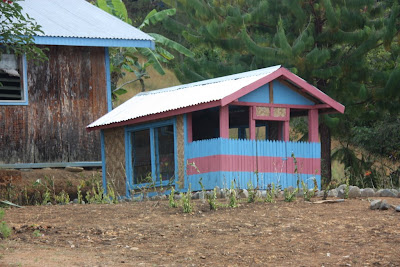
One other note, we did see the grave of the village and church elder who had died. He wanted to be buried near the church (it's the brown building in the background). This is the traditional grave for those who can afford it here. (Or those who are important enough that their families feel they should spend the money on such grave sites.) Inside the small house is the coffin, above ground, surrounded by flowers. I have seen other such graves along the roads here, both the stone and dirt roads up the mountain and the main road back into Mt Hagen. This is the traditional way to bury
Big Men, that is civic leaders. (I need to ask how long the graves stay like this, as I have not seen more than one or two in a village.)
In all, a very interesting day.
No comments:
Post a Comment